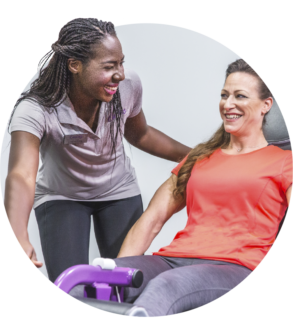How to Listen to Your Body
Why do you work out? Maybe you want to lose weight. Or perhaps you’re more focused on improving your balance with core exercises for women, toning your muscles, and getting in shape. No matter what your fitness relationship goals, surely they include improving your body in some way. We never start a gym workout or new exercise routine to do our bodies damage. But if we don’t progress with a workout plan the right way or start out too hard, we can end up doing more harm than good, the result being injury or burnout. That’s why it’s so important to listen to your body when it comes not only to exercise, but to diet and other lifestyle habits you regularly engage in, too.
Your Body is Naturally Designed for Feedback
By nature, our bodies are designed for letting us know when we’re overdoing it. Pain, exhaustion, anxiety, and stress are all signs and symptoms that we’re pushing too hard. As such, it’s important to pay attention to these warning signs and adjust your exercise routine or healthy eating plan accordingly.1
Recognising signs of a problem
When you’re starting a new exercise routine, your body goes through an adjustment period. Sometimes, it’s tough to tell the difference between normal “getting in shape” and signs you’re working out too hard. To help, here are some signs you’re getting too much physical activity:
- You feel anxious about your gym workout
- You can no longer perform at the level you used to be able to when you engage in a full body workout
- You feel depressed and demotivated when it comes to your exercise routine
- You feel more tired than usual
- You need longer periods of rest between workouts
- You experience mood swings or feel irritable
- You’re having trouble sleeping
- You’re getting sick more often than normal2
Difference between soreness and pain
As you think about whether you are experiencing these signs of over-exercising, it’s important to note the difference between soreness and pain. Some degree of muscle soreness after a whole body workout is a good sign—it means you stressed the muscle, which is what causes muscles to get stronger. “Good” soreness usually sets in within a few hours and peaks one to two days after a tough full body workout. It’s important to stress your muscles gradually. If you jump into strength exercises for women too quickly, you can cause a lasting muscle injury that can sideline you from your workout plan for an extended period of time. Other injuries that can result from too much exercise too fast include tendonitis, stress fractures, and damage to cartilage.3
It can sometimes be tricky to distinguish muscle soreness and pain due to injury. In general, if a muscle feels tight or achy and affects a whole muscle group rather than one specific spot, it’s probably soreness. If the pain is more deep, sharp, stabbing, and localised to a small area, it’s more likely an injury. Swelling is another sign something is wrong.4
Know when to take time off
Part of being a smart athlete is knowing when to push and when to back off during your workout plan. Whether you’ve just started a program that incorporates easy exercises for women or you’ve been engaging in your exercise routine for years, it’s important to listen to your body and include rest in your fitness routine. Rest is an important part of getting in shape and maintaining optimal health and fitness. Keep in mind rest can take many forms. If you want to incorporate some kind of physical activity into every day, that’s OK; just make sure you vary your workout plan. Engage in a weight workout for women one day, a cardio class the next, and make time for flexibility the next. Stretches for women are an important element of fitness and help maximise performance during your gym workout and prevent overuse injury. And if you feel pain that signals an injury, cut back on your exercise routine or completely rest for one to two weeks. In many cases, that’s all it takes to recover and get you back in action again.
If your pain or fatigue persist after those one to two weeks of rest, talk to your health care provider. You may need to take a break from your exercise routine longer. Your provider can help you decide when it’s safe to resume your workout plan.5
One of the many great things about Curves is that there are health and fitness professionals on site to help you perform muscle exercises for women safely and effectively, so you can hopefully avoid pain or injury. Your Curves Coach can also help you tailor a healthy eating plan that supports your gym workout, so you can get healthier from the inside out and achieve and maintain all your weight loss and fitness relationship goals. When it comes to listening to your body, an extra set of ears always helps!
To find out more about how you can informed lifestyle and health choices, visit our blog under the ‘Live‘ category! You can also learn more about how the ‘Curves Circuit‘ can benefit your lifestyle here.
Sources:








